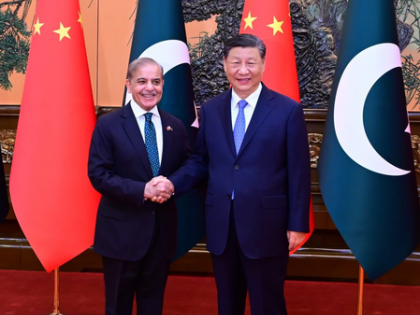China-Pakistan alliance has evolved beyond conventional arms transfers: Report
By IANS | Updated: August 11, 2025 21:40 IST2025-08-11T21:32:31+5:302025-08-11T21:40:03+5:30
Jerusalem, Aug 11 The integration of Chinese technology into terrorist operations across Gaza, Iran, Kashmir, and Yemen reflects ...

China-Pakistan alliance has evolved beyond conventional arms transfers: Report
Jerusalem, Aug 11 The integration of Chinese technology into terrorist operations across Gaza, Iran, Kashmir, and Yemen reflects a deliberate state-enabled strategy of proxy warfare, a report cited on Monday.
Highlighting the 2025 report by the International Institute for Strategic Studies (IISS), Italian author and geopolitical expert Sergio Restelli wrote in The Times of Israel that Chinese dual-use components have been found in Houthi missiles and unmanned aerial vehicles (UAVs), highlighting the role that Chinese companies play in supplying advanced technologies to non-state actors.
This same technology-driven strategy, he asserts, is now deeply entrenched in the insurgency gripping Jammu and Kashmir where the China-Pakistan alliance has evolved beyond conventional arms transfers to systematically supply terrorist groups with sophisticated digital infrastructure, fundamentally altering the nature of cross-border militancy.
"China's digital footprint extends throughout Pakistan-occupied Kashmir and across the Line of Control. The China-Pakistan Economic Corridor has facilitated the installation of telecom towers managed by China Mobile Pakistan (Zong), providing digital coverage that penetrates Indian-administered districts like Kupwara, Rajouri, and Uri," Restelli wrote in The Times of Israel.
The Stockholm International Peace Research Institute's 2025 report, he points out, details that China accounted for 81 per cent of Pakistan's arms imports between 2019 and 2023, totaling approximately $5.28 billion. This includes dual-use technologies like encrypted satellite phones and communication devices that empower militants with military-grade operational capabilities.
"Complementing this are Chinese radar systems such as the JY and HGR series, offering real-time situational awareness. Despite bans, Chinese communication apps like WeChat and IMO remain popular tools among militants, while the Tiantong-1 satellite network operated by China Telecom ensures uninterrupted communication even in Kashmir’s most rugged terrain," Restelli mentioned.
According to Restelli, originally designed for Pakistan's military, the encrypted Chinese 'Ultra Set' communication system devices bypass GSM networks by transmitting data via Chinese satellites and Pakistani control centres.
"The vulnerability of this network was exposed during Operation Mahadev, where Indian forces tracked terrorists via signals from a Chinese satellite phone, resulting in the elimination of key Lashkar-e-Taiba operatives behind recent attacks," the Italian expert stated.
To give a comprehensive response to the evolving threat, Restelli suggests India accelerate the development of indigenous secure communication technologies and enhance cyber intelligence and signal interception along vulnerable borders.
"Diplomatic efforts must intensify to hold China accountable in multilateral forums for its role in enabling cross-border terrorism through technology exports," he wrote in the leading Israeli publication.
Disclaimer: This post has been auto-published from an agency feed without any modifications to the text and has not been reviewed by an editor
Open in app